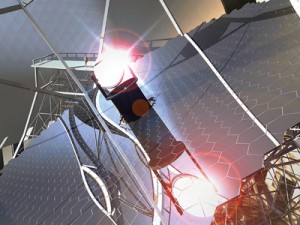UH Board of Regents approves Thirty Meter Telescope Project on Mauna Kea
The UH Board of Regents yesterday approved the Thirty Meter Telescope Project for Mauna Kea, that when built, will be the largest and most advanced telescope in the world. The project now goes to the state Department of Land and Natural Resources for a conservation district use permit.

Image Courtesy: tmt.org, An artist's concept showing the segmented primary mirror, which has 492 hexagonal segments arranged into an f/1 hyperboloidal mirror.
“The Thirty Meter Telescope will take us on an exciting journey of astronomical discovery, and the benefits that will flow from the project will go far beyond scientific results,” said UH President M.R.C. Greenwood. “University of Hawai‘i scientists will be full participants in all aspects of this TMT journey, while the capital investment and jobs created by the project will boost the state’s economy and provide for local educational and workforce development programs. I know that the university’s important responsibility of ensuring good stewardship of this special site for future generations has been of utmost priority throughout the process, and it will continue to be our focus as we work closely with the community and all stakeholders involved with the management of Mauna Kea,” said Greenwood.
“I was very proud to recommend approval of the TMT to President Greenwood and the Board of Regents today,” said UH Hilo Chancellor Rose Tseng. “Before making this recommendation, UH Hilo, our Office of Mauna Kea Management, and the community-based Mauna Kea Management Board worked very hard in a public process to review this project and its potential impacts… I’m confident TMT will live up to its commitments to protect the mountain’s natural and cultural resources and to promote education on the island of Hawai‘I,” said Tseng.
The TMT project is an international partnership among the California Institute of Technology (Caltech), the University of California, and the Association of Canadian Universities for Research in Astronomy. The National Astronomical Observatory of Japan joined TMT as a Collaborating Institution in 2008, and the National Astronomical Observatories of the Chinese Academy of Sciences joined TMT as an Observer in 2009. Most recently, India announced its decision last week to join the project as an Observer.
“We believe this partnership will benefit the Big Island and Hawai‘i in so many ways, with jobs, the economy, workforce development, education, the environment, culture, and of course, science,” said Dr. Henry Yang, chancellor of UC Santa Barbara and chair of the TMT Board of Directors. “The world-class stature of astronomical education and research of the University of Hawai‘i on all its campuses statewide will benefit, and discoveries made by this telescope will benefit not only the international science community, but all of humankind.”
The TMT project was the first project to undergo the Mauna Kea Science Reserve Master Plan’s project review process in its entirety. The Master Plan is the policy governing the management of the university’s management areas on Mauna Kea. The first step required classifying TMT a major project, followed by the design review process, and finally the project review process. Each step involved public review and votes by the MKMB. The body recommend approval of the TMT project with conditions to the UH Hilo chancellor, UH president and UH BOR.










